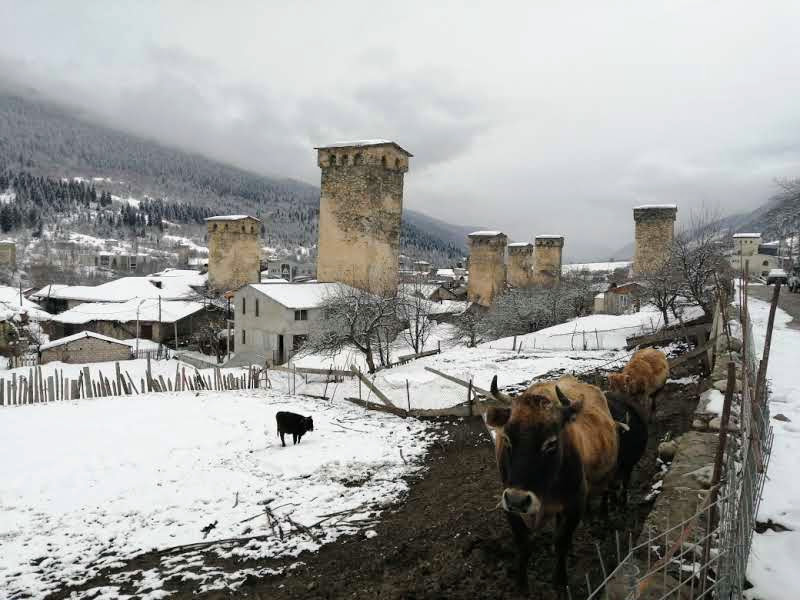There is never a dull moment in Georgia! This ancient country, where eastern history and European modern culture chaotically collides, offers travelers a world-class blend of breathtaking landscapes, rich traditions, and warm hospitality.
Planning a Georgia trip? Check out this quick travel guide to Georgia with my personal favorites to ensure your trip to Georgia is an unforgettable adventure. Whether you’re exploring ancient cave cities, scaling mountain peaks, or sampling the purest natural wines, I’ve got you covered!
შიგთავსი:
1. Explore Tbilisi Old Town
2. Visit Kazbegi (Stepantsminda)
3. Enjoy Georgian Cuisine
4. Visit Mtskheta
5. Day-Trip to Gori
6. Soak In the Sulfur Baths
7. Checkout Some Soviet Architecture
8. Explore Some Nightlife
9. Fly Up to Svaneti
10. Visit Ushguli
11. Vardzia – Real World Moria!
12. Go Skiing in Gudauri
13. Head to the Beach at Batumi
14. Explore Kutaisi
15. Visit Borjomi
16. Catch a Rugby Game
17. Remote Working
18. Marshrutkas
19. SIM Cards
20. FAQs
Must-See for a 1-Week Trip
If you only have one week to explore Georgia, focus on these spots in Tbilisi and the surrounding area:
Explore Tbilisi Old Town
Tbilisi Old Town is one of the most famous places to visit in the Republic of Georgia. It’s the heart of the capital, founded on hot springs. The area is full of beautiful Georgian courtyards, steaming bathhouses, and winding streets with traditional basement restaurants and cozy wine bars. This is the best place to stay when you first arrive because you can explore most of the city’s sights on foot.
My top tip: Get the cable car over the Old Town to the castle for stunning views of the beautiful balconies and courtyards from above. It’s part of the city public transport system and costs only 2.5 Lari (less than $1)!
Visit Kazbegi (Stepantsminda)
Kazbegi is absolutely unmissable during your travel in Georgia country. Nearly every guidebook or blog about Georgia country travel will use the Gergeti Trinity Church as the cover image. It’s only a short drive from Tbilisi (about 3 hours). You can hike up to the monastery for breathtaking views, but be careful in winter because it can get icy. You might even be joined by huge Georgian shepherd dogs—they look like wild wolves but are very friendly!
My top tip: Stock up on some delicious mountain Chacha from Kazbegi Good Food—the owner ages it in brandy barrels. But be careful, it’s somewhere between 60-80% alcohol!
Enjoy Georgian Cuisine
No trip to Georgia is complete without endless local food and wine! Georgian cuisine is famous for its unique dishes and top-quality natural wine. While I have had great Georgian food in London, Berlin, and Kyiv, nothing beats home-cooked Georgian classics with great company in Georgia!
My personal favorite dishes are khinkali (dumplings), Adjarian khachapuri (cheese bread with an egg), and shkmeruli (fried chicken in garlic sauce). For wine, I love a dry red Saperavi and an Orange-Qvevri-Wines, which are fermented in large earthenware vessels.
My top tip: Eat as much as you can! Aim for a khinkali coma! My favorite old-school local Georgian restaurants in Tbilisi are Racha and Mapshalia. Thank me later!
Visit Mtskheta
Just outside Tbilisi (20km), you can hop in a taxi and head to Mtskheta, often called Georgia’s little Jerusalem. It was the historic capital of the Kingdom of Kartli and is now the center of the Georgian Orthodox Church. Mtskheta is like a living museum with several ancient churches and monuments. Don’t miss the 4th-century Samtavro St. Nino Church and the 6th-7th century Jvari Church, both of which are UNESCO World Heritage Sites.
My top tip: Head up to Jvari Monastery for a view of the rivers meeting and the city below—another classic Georgian postcard spot!

Day-Trip to Gori
Gori is only a few hours from Tbilisi and is famous as the birthplace of Stalin. You can visit the small wooden house where Stalin was born in 1878 and the Stalin Museum, which is pretty unmissable.
The museum feels like a Soviet relic that hasn’t gone through any De-Stalinization. While you’re in Gori, spend some time grabbing lunch and walking around the cute old town. If you’re not in a rush, you can also climb up to Gori Fortress for a great view.
My top tip: Remember, the Stalin Museum is a living, breathing Soviet-era relic, so question everything. Do your own research and check various sources about any information presented there.

Soak In the Sulfur Baths
The sulfur baths in Tbilisi are a must-visit during your trip to Georgia! The city was built around these hot springs. The iconic sulfur baths in the Abanotubani neighborhood are easily recognizable by their steaming brick domes. The waters are naturally warm and are believed to have health benefits. You can visit a public bath for 10-15 GEL per person per hour or rent a private bath for a more luxurious experience.
My top tip: My personal favorite is the Chreli-Abano, where famous writers Alexandre Dumas and Alexander Pushkin once bathed. It was recently refurbished and has a gorgeous Silk Road vibe!

Checkout Some Soviet Architecture
Tbilisi and Georgia, in general, are home to some stunning examples of Soviet Modernist architecture. In the capital, you can find metro mosaics, brutalist sky bridges, and museums that look like they belong in a sci-fi movie. My favorite Soviet mosaics can be found at Technical University, Rustaveli, Isani, and Ghrmaghele metro stations.
My top tip: Jump on the metro and step back in time as you explore these Soviet-era designs.
Explore Some Nightlife
Tbilisi has amazing nightlife, and one of the reasons I keep returning is for the clubs. Tbilisi is like Berlin without the hassle. While face control is still a thing, you can easily get into some of the best techno clubs in the world without hunting down guest lists or waiting in long lines. If clubs aren’t your thing, there are plenty of bars and wine bars to explore. Fabrika and Wine Factory are popular spots.
My top tip: Georgian nightlife starts late. Don’t hit the clubs before 2 a.m. Bassiani is a lot of fun after 5 a.m. Just take a disco nap until midnight and then kick off your night!
Two-Week Trip
With two weeks in Georgia, you can explore more remote regions and dive deeper into the country’s diverse landscapes and cultures.


Fly Up to Svaneti
Svaneti is a remote mountain region on the border with Russia, often labeled the mythical land of the Golden Fleece from the tale of Jason and the Argonauts. This region is a must-visit during any traveling in Georgia.
Eerie towers stand silently, watching over the breathtaking landscape. These defensive structures were built between the 9th and 12th centuries and are still part of the households today. Mestia is the main base for exploring the area and is great for skiing in the winter and hiking or mountain biking in the summer.
My top tip: Book a flight from Tbilisi to Mestia in advance through Vanilla Sky. The bumpy old plane ride over the mountains is amazing and takes only half an hour, but the drive is about 12 hours and might require a 4WD!


Visit Ushguli
Hidden at the foot of Shkhara Mountain (5,068m, 16,627ft), Ushguli is the highest permanent settlement in Europe and a true gem of the Svaneti region. This remote village offers a glimpse into a world untouched by time, where ancient Svan towers rise against the dramatic backdrop. The famous four-day trek from Mestia to Ushguli is a highlight for travellers to Georgia.
My top tip: If hiking isn’t your thing you can drive from Mestia to Ushguli. The road is rough and often requires a 4WD, especially in wet conditions. The journey takes about 2.5 hours, with stunning views of the Svaneti landscape along the way.
Vardzia – Real World Moria!
Vardzia is a stunning ancient cave city and monastery site in southern Georgia, with over 3,000 caves. It was built by the legendary Georgian Queen Tamar to shelter from the Mongol hordes. A huge earthquake caused the mountainside to slip away, revealing the cave city underneath. It’s an amazing place to explore, with unbelievable views. If you’re a fan of “The Lord of the Rings,” this place might remind you of the real-world Moria!
My top tip: Spend the night in the nearby town of Akhaltsikhe, which has a huge restored Ottoman-era castle and easy connections to other top spots on this list.
One-Month+ Trip
A month in Georgia allows you to explore every corner of my favorite country:
Go Skiing in Gudauri
Gudauri is the largest and highest ski resort in Georgia, just a couple of hours north of Tbilisi. It’s perfect for skiing and snowboarding, with 17 lifts and 34.8 km of slopes for all levels. A ski pass is incredibly affordable, costing only GEL 70 (about £20) a day. Even if you’re not into snow sports, you can visit Gudauri on the way to Kazbegi and take a couple of gondolas for stunning views from the peaks.
My top tip: Gudauri is a great place to learn skiing because the slopes are above the tree line, so there’s less to hit. Plus, the prices for lessons and equipment are unbeatable!
Head to the Beach at Batumi
Batumi is the second-largest city in Georgia and a popular Black Sea coast resort. It has a fun mix of old and modern architecture, making it an interesting place to visit year-round. The city is known for its diverse architectural styles, from 19th-century Baroque to contemporary abstract buildings. Batumi is also a great starting point to explore the lush Adjarian region of Western Georgia.
My top tip: Visit the Batumi Botanical Gardens and explore the huge Kolkheti National Park by boat or kayak. It’s known as the Georgian Amazon!
Explore Kutaisi
Kutaisi, one of Georgia’s major cities, was the capital of the legendary Kingdom of Colchis. The city is famous for the 11th-century Bagrati Cathedral and the beautiful Rioni River. While Kutaisi is now known for its affordable airport, it’s worth exploring the city’s historical sites, like the Colchis Fountain, decorated with replicas of ancient gold artifacts found in the region.
My top tip: From Soviet times until the late ’90s, Kutaisi was rumored to be the motherland of the Georgian Mafia. Check out the extravagant and lavish graves in the Sapichkhia and Oghaskura Cemeteries to see for yourself.
Visit Borjomi
Borjomi is famous for its sparkling water, which is one of Georgia’s most recognizable international brands. The city itself is located on the Mtkvari River (same as Tbilisi) and was a popular Russian imperial and later Soviet spa city. While tourism declined after the USSR broke up, Borjomi is still worth a visit. You can even try Borjomi water straight from the source!
Top tip: Take a hike through the forest to discover the Borjomi Sulfur Pools—an open-air thermal spring with water temperatures of 30-32°C year-round, originally built by the Imperial Romanovs. We visited in the middle of winter, with snow blanketing the forest, and the hot spring was a perfect way to warm up. Just be sure to dry off and bundle up quickly afterward to stay warm!
Catch a Rugby Game
Rugby is rapidly growing in popularity in Georgia, with the national team, the Lelos, making impressive strides on the international stage despite facing significant challenges. The sport has deep roots in Georgian culture, tracing back to the traditional game of Lelo Burti (Georgian: ლელო ბურთი), a full-contact sport similar to rugby that has been played for centuries.
Top tip: If you’re in Tbilisi, try to catch a Georgian national team game at Dinamo Tbilisi Stadium. You can often score pitch-side seats at an incredible price!
Practical Tips
Remote Working

Georgia is one of my favorite spots for remote work. The relaxed entry requirements (365 days visa free for UK and US citizens), affordable lifestyle, and friendly locals make Georgia a remote work dream. My favorite spot to work is Fabrika, where you can order tasty food and drinks while getting work done. But always check with the staff first to make sure it’s okay to work on your laptop.
My top tip: Get unlimited mobile data for 3 Lari (about $1.10) a week with Magti. It works throughout the country and is a lifesaver when working from mountain lodges or on the go.
Marshrutkas
No travel guide to Georgia is complete without mentioning the mighty Marshrutka. These shared buses are chaotic, bumpy, and fast—sometimes too fast! They’re a lot of fun, but be prepared for some surprises along the way. Sometimes, the driver might decide to end the route early, leaving you in the middle of nowhere, but that’s part of the adventure!
My top tip: Don’t be afraid to ask questions when taking a Marshrutka! While there might not be a set schedule, someone will always be happy to help you find the right bus.
SIM Cards
Data is very affordable in Georgia, and you can find great deals to stay connected during your traveling in Georgia. I got unlimited mobile data for 3 Lari (about $1.10) a week with Magti. Grab a SIM card when you arrive and ask about the unlimited data plans.
My top tip: Load enough Lari onto your mobile account to cover your entire trip. You don’t want to be caught without data or Wi-Fi!
This ultimate travel guide Georgia country covers everything you need to know for an unforgettable vacation to Georgia country. From the buzzing streets of Tbilisi to the serene mountains of Svaneti, there’s something for everyone in this incredible gem. Safe travels!
Georgia (Country) Vacation FAQs
How Many Days is Enough for Georgia (Country)?
It’s tough to set a strict time limit because there’s so much to explore when visiting the country of Georgia. In just one week, you can cover many of the main sites, including day trips from Tbilisi to places like Kazbegi and Mtskheta. With two weeks, you can venture into more remote areas, such as Svaneti, and truly immerse yourself in the local culture.
If you have a month or more, you can explore every corner of the country, from the Black Sea coast to the eastern wine regions. No matter how long you stay in Georgia, it will leave you wanting more.
Which is the Best Month to Visit Georgia?
The best time to visit really depends on what you want to experience. I first visited in September, which was perfect for enjoying outdoor events and the coastal city of Batumi. Winter is ideal for snow sports enthusiasts, as Gudauri and other ski resorts come to life.
Every season offers something unique, so you can’t go wrong no matter when you visit. However, Georgian friends have mentioned that summer can be too hot, so if you prefer cooler weather, consider spring or autumn for your Georgia country trip.
Is Georgia a Cheap Country to Visit?
Yes, Georgia is very affordable, making it easy to stretch your budget and enjoy more during your trip to Georgia country. Public transport, like the Marshrutkas, covers the main sites at a low cost, and you can find excellent deals on accommodations.
Eating and drinking at local spots is highly recommended as the quality is superb and the prices are unbeatable. Overall, traveling in the Republic of Georgia is budget-friendly, allowing you to enjoy a rich experience without breaking the bank.
What is the Best Way to Travel Around Georgia?
The best way to travel around Georgia depends on your budget and how much of the country you want to explore. The cheapest option is the Marshrutka, which covers all the major sites and is ideal for day trips from Tbilisi. If you want to explore more remote areas, hiring a private driver is an affordable and convenient option, especially for out-of-the-way places.
For the ultimate freedom, renting your own 4WD vehicle is highly recommended. This allows you to explore every hidden corner of the country at your own pace. No matter your choice, make sure to have travel insurance for peace of mind during your Republic of Georgia travel guide adventure.

